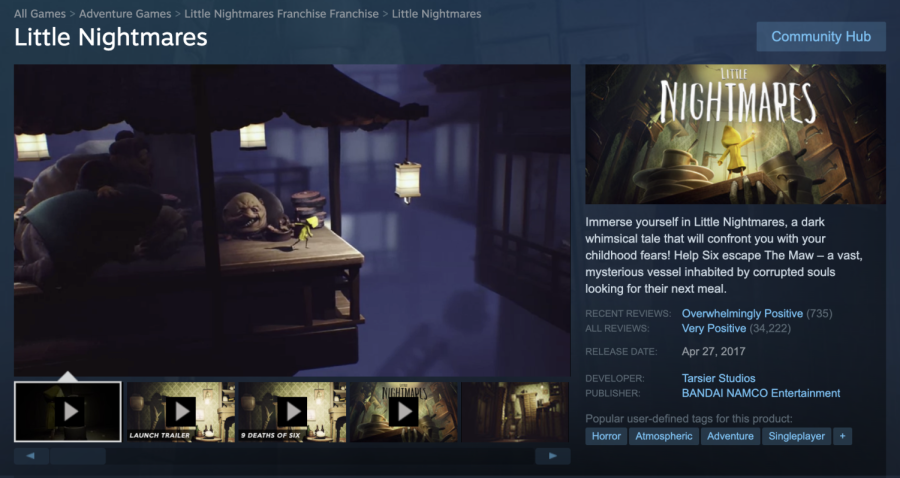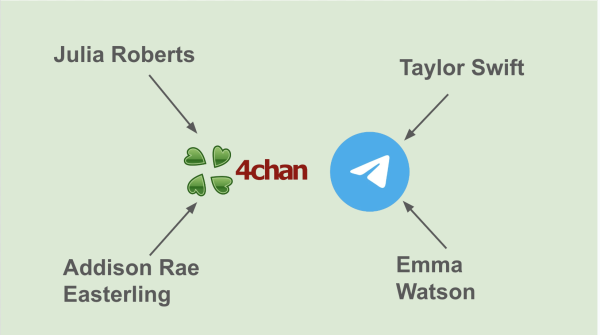Column: Smaller than life
Photo credit: Paulina DePaulo
A screenshot of “Little Nightmare’s” profile on Steam, a popular video game marketplace. “Little Nightmares” is a 3D puzzle-platformer that follows the adventures of main character Six in an underground resort complex.
January 27, 2023
Video games, in many cases, give the player the feeling of being giant. Whether you make crucial decisions that can alter a character’s journey or manage entire kingdoms with just your fingertips, these digital stories are often manipulated through the player’s omniscient power.
But what if that wasn’t the case?
“Little Nightmares,” a third-person puzzle-platformer game, makes you feel exactly as the title sounds: little. In the puzzle-platformer style, players strategically move from left to right, using elements from the world to advance. Players take control of a little girl named Six (who, ironically, is actually 9 years old), an orphan stuck on the bottom level of an underwater resort complex built for the elite.
At the very start of the game, players are left without any context regarding the setting, backstory and even the character they’re controlling. It’s disorienting at first, as you’re left to navigate the dark, expansive tunnels as a 10-inch girl with nothing more than a lighter. I’ll be honest: it took me way longer than it should have to find my bearings in the world without even encountering a single monster, and I’d argue that was completely intentional.
As you scurry across bridges and crawl through air ducts, the sheer scale of the infrastructure is haunting, constantly reminding you just how small you are. The unsettling sound effects and visuals add another incredible layer to the game, from the jarring character design of the monsters to the dripping of water that rings constantly in your right ear. Every last detail perfectly captures the feeling of cold abandonment and suspense, fully immersing you in Six’s adventure.
Additionally, the monsters themselves are intensely portrayed, each one being grotesquely large to drown out Six’s tiny frame. As you move horizontally through the world, you encounter numerous bosses that you must avoid in clever, stealthy ways. You might find yourself hiding behind book shelves to avoid the angry, long-limbed librarian or end up swinging on meat hooks to sneak by the hoard of chefs in the kitchen.
As with any good story game, you slowly discover crucial pieces of information about the complex you’re in, the enemies and even Six herself. There are moments of contemplation, revelation and emotion, without a single bit of dialogue involved. The atmosphere does all the talking necessary, and it’s a wonderful experience.
From the moment I pressed “play,” I was astonished by the level of detail and depth of the environment in “Little Nightmares.” Even though I had to play through half of it without sound and lean on my friends for moral support, I absolutely loved the thrill of it. It was overwhelmingly exciting to finally crack the code in a tricky room and equally as stressful — yet, still fun — to race behind cabinets before the dishwashing ogre caught up.
The game demonstrates the power of being little in a big world, giving you ways to sneak past areas only the tiny could execute. You go from feeling powerless in an unfamiliar world to defeating giant beasts with nothing but wit. It’s a quick and thrilling game, with mountains of lore and extra content to indulge in afterward. There’s even a prequel that was released recently, titled “Little Nightmares II.”
You may start the game out small, but there’s no doubt you’ll leave “Little Nightmares” feeling larger than ever.





![Freshman Milan Earl and sophomore Lucy Kaplan sit with their grandparents at Archer’s annual Grandparents and Special Friends Day Friday, March 15. The event took place over three 75-minute sessions. “[I hope my grandparents] gain an understanding about what I do, Kaplan said, because I know they ask a lot of questions and can sort of see what I do in school and what the experience is like to be here.](https://archeroracle.org/wp-content/uploads/2024/03/grandparents-day-option-2-1200x800.jpg)





























































